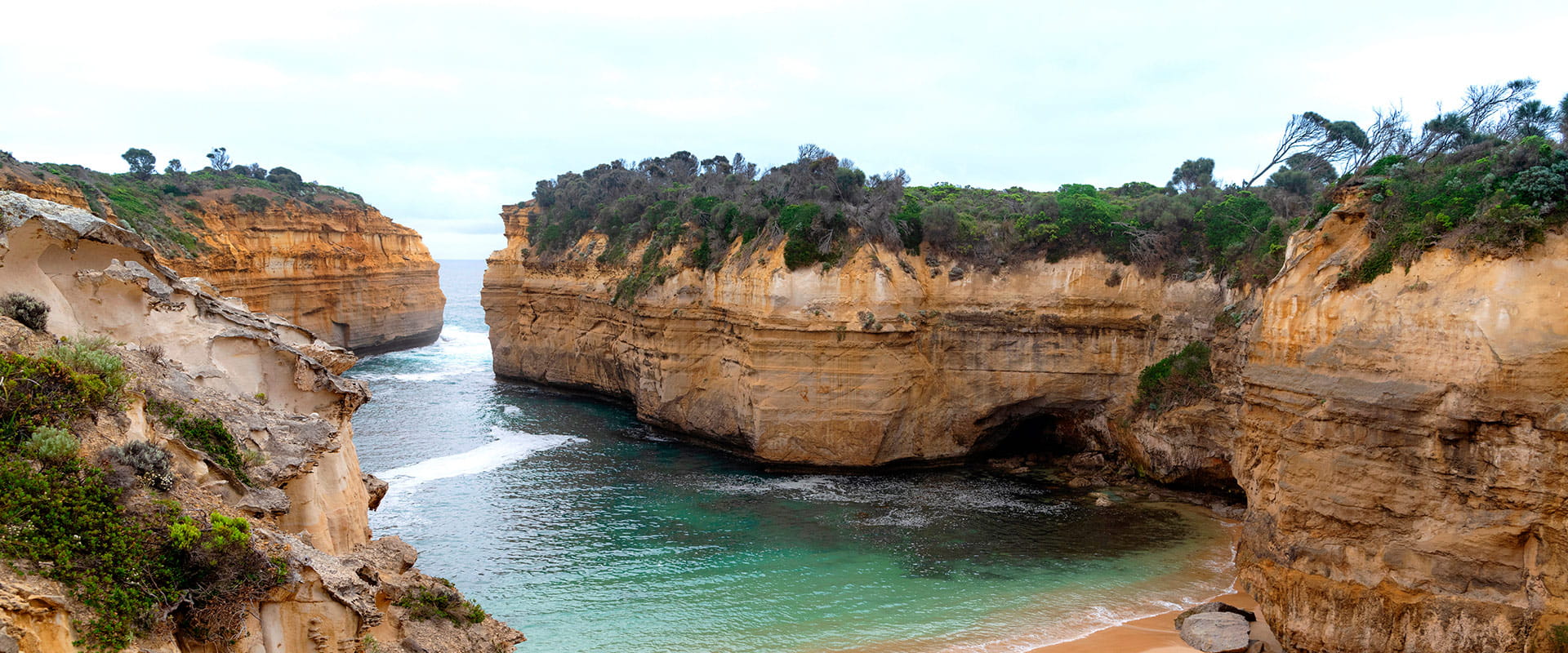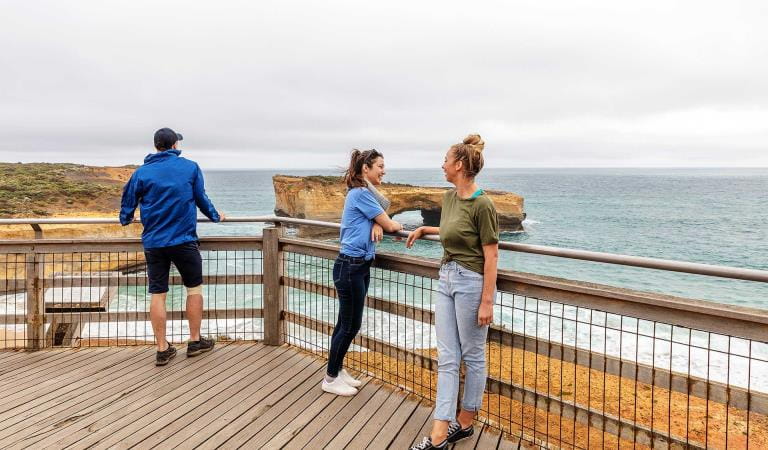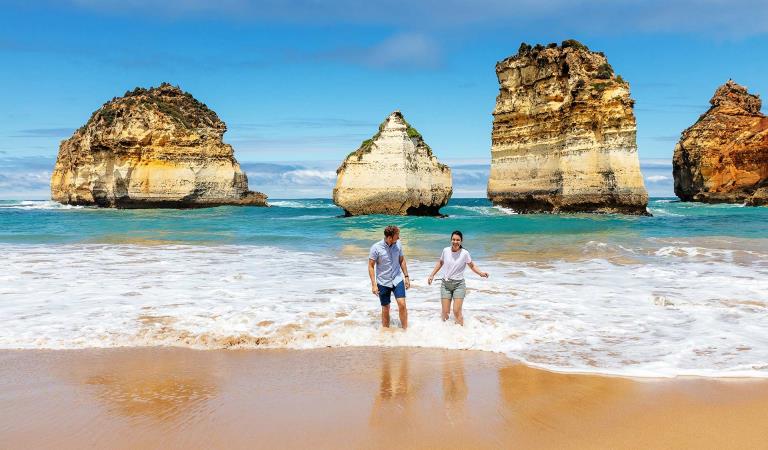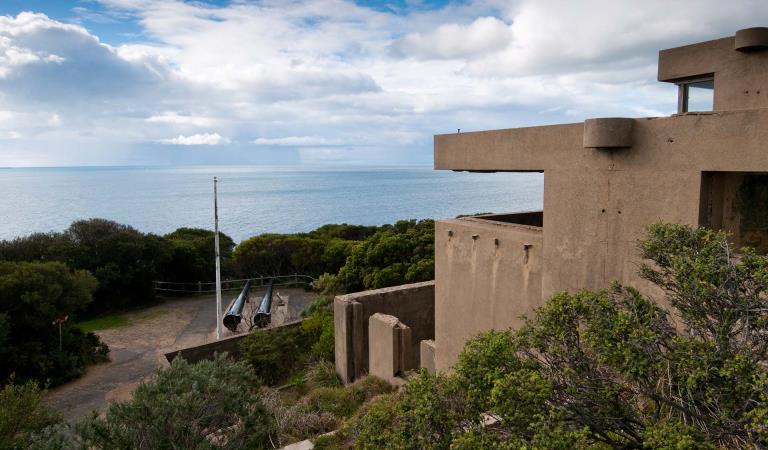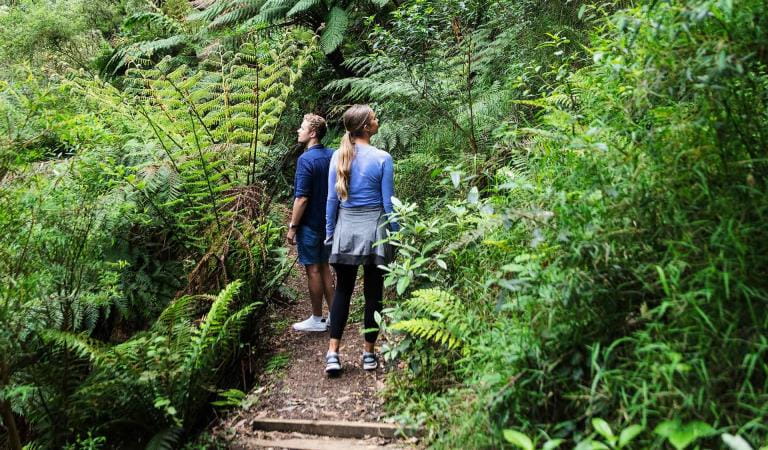Explore
Loch Ard Gorge
Loch Ard Gorge is the site of the most famous shipwreck on the aptly named Shipwreck Coast. The Loch Ard ran aground crashing into Mutton Bird Island in 1878. The only two survivors Tom Pearce and Eva Carmichael managed to drag themselves to the safety of the beach inside Loch Ard Gorge. For a moment, these two tragic teenagers were the talk of the English-speaking world, which very much hoped they would marry (they did not). Walk along this sandy beach, dramatically closed in by towering sandstone cliffs. Explore several other short walks in this area including the cemetery where Tom and Eva’s less fortunate shipmates are buried.
A short walk from Loch Ard Gorge, Mutton Bird Island used to be called ‘The Sow’ back in the days when the Twelve Apostles were known as ‘The Sow and Piglets’. Every spring and summer the island is home to a noisy colony of Short-tailed Shearwaters (aka muttonbirds). Every day at dusk between October and April, these birds flock home to their burrows in their thousands, to feed hungry chicks. Experience this incredible natural event before heading to Port Campbell for dinner and an overnight stay.
Things to do in the area
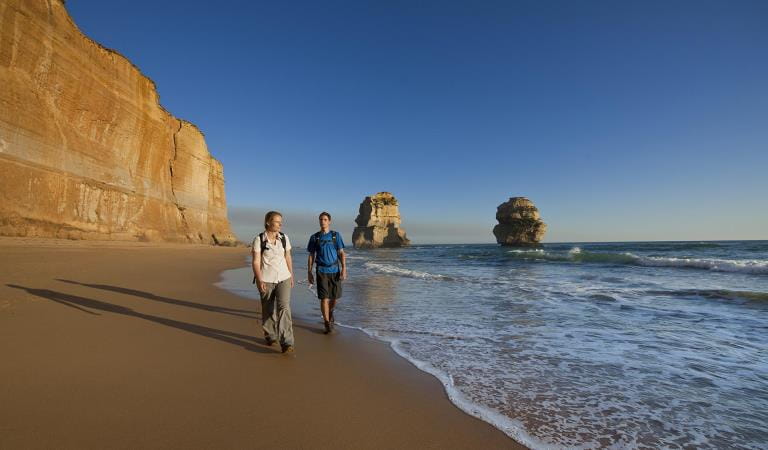
Gibson Steps
London Bridge

The Grotto
Twelve Apostles
How to get there
Loch Ard Gorge
When you're there
There are several easy walking tracks and three of them have storyboards revealing the area's wildlife, history and geology:
- Geology Walk - Discover the secrets of the forces that shape the coastline on this easy self‐guided walk.
- Shipwreck Walk - Follow the tragic story of the Loch Ard shipwreck site to the cemetery. This amazing story of courage and survival is also featured in Warrnambool’s Flagstaff Hill Maritime Village.
- Living on the Edge - Discover the lives of plucky Short-tailed Shearwaters on the edge of the sheer cliffs. This easy walk encompasses the Mutton Bird Island viewing platform, Thunder Cave and Broken Head.
Download the Port Campbell National Park visitor guide for more information about the park and the plethora of experiences to be had within its borders.
Need to know
Loch Ard Gorge
Accessibility
Visiting a park can be more of a challenge for people with disabilities, however in Victoria there are a wide range of facilities to help people of all abilities enjoy our wonderful parks around the state.
To make it easier for people with limited mobility to see the all abilities access and experiences on offer at Twelve Apostles and Loch Ard Gorge walks, Parks Victoria has released this video - produced and narrated by accessibility advocate Ryan Smith, who uses a wheelchair.
Assistance dogs are welcome in Parks Victoria parks and reserves. Entry requirements apply for parks and reserves that are usually dog prohibited, such as national parks.
Tread lightly as the coast is fragile and your safety matters. Stick to marked trails to avoid injury, and to protect the delicate coastal vegetation and wildlife that call the park home.
Change of Conditions
Nature being nature, sometimes conditions can change at short notice. It’s a good idea to check this page ahead of your visit for any updates.
-
Loch Ard Gorge (Twelve Apostles Marine National Park, Port Campbell National Park)
Loch Ard Gorge Beach Access Steps Closed
Loch Ard Gorge beach access steps are currently closed due to geological instability. The site will remain closed until remediation works are completed to remove the hazards and ensure visitor safety.
-
Notices Affecting Multiple Sites
Twelve Apostles Precinct- Change of Conditions Update Notice as of 20.10.2025
General Public InformationDue to ongoing construction works at the Twelve Apostles Visitor Centre, significant changes to access and parking arrangements will be in effect from Friday, 19th September 2025. All visitors are asked to plan ahead and be patient when travelling to the site during this busy period. High visitation is expected in-line with School and Public HolidaysKey changes and reminders for visitors include:- Temporary
Changes to Parking:
Construction works have resulted in temporary parking areas and altered traffic flow. Expect reduced speed limits, changed parking arrangements, and traffic management on-site. Please see attached map. - Car
Parking:
In the event of full parking capacity, visitors are encouraged to seek alternative destinations such as Port Campbell township or Bay of Islands, and encouraged to return later in the day. - Pedestrian
Safety:
Use designated walkways and pedestrian crossings only. Do not climb fences or viewing barriers. - Environmental
Care:
Protect this unique landscape by staying on paths, respecting barriers, and taking your rubbish with you. - Bushfire
Safety:
Stay informed by visiting emergency.vic.gov.au, downloading the VicEmergency app, or calling the VicEmergency Hotline on 1800 226 226.
For more information, contact Parks Victoria on 13 1963 or visit parks.vic.gov.au
Licensed Tour Operators (LTOs)
IMPORTANT – Operational and Access UpdateFrom Friday, 19th September 2025, the following updates apply to all Licensed Tour Operators visiting the Twelve Apostles:New Access & Parking Procedures:- Coach/Bus/Coaster
Access:
All LTO vehicles must access the temporary parking area via Booringa Road and the new entry/exit road. Directional signage will be in place. Please see attached map. - Temporary
Parking Area:
Use designated bays only. This area has been established during current construction works. - Drop-Off
Instructions:
- All
vehicles (with or without trailers) must drop passengers
at the front of the Visitor Centre.
- Pick-ups
are not permitted at the drop-off zone.
- Drivers
must proceed immediately to the designated parking area
after drop-off.
- Provide
passengers with clear directions and walking instructions before they
disembark.
Traffic Management:- Follow
Traffic Controller Instructions at all times when management is
in place.
- Be
prepared for redirection to alternative parking areas based on
capacity.
- Observe
on-site signage directing different vehicle sizes to specific parking
bays.
Operational Reminders:- Permit
Display: Ensure your LTO permit is clearly displayed on
your vehicle at all times.
- Passenger
Safety: Remind passengers to use designated walkways and not to climb
fences or barriers.
- Journey
Planning: Allow extra time, travel safely, and prepare staff for
delays due to high visitation and traffic coordination.
Stay Informed:- Further
updates and staging plans are available at the Development Victoria
website:
www.development.vic.gov.au/projects/twelve-apostles?page=resources
Thank you for your cooperation in maintaining a safe and enjoyable experience for all visitors while works are underway. Your support is essential in protecting the Twelve Apostles and surrounding areas.Attachments: LTO Map Updated 17.10.25 Conditions A3 (98KB)
- Temporary
Changes to Parking:


